Making liquid soap is daunting because it’s a weird process. But it’s also pretty simple. In fact, the full description of the process takes longer to read and understand than actually doing the work.
I’ve produced this as a single recipe with quantities for a member of The Commentariat(tm) who wants to give it a try. So where I put specific quantities, you can use them and make exactly what I did, or there are links at the bottom for how to compute your own quantities based on different oils.
This process takes about 4 hours start to finish, but you’ll only actually do a little work. But you have to be there to deal with it; you can’t just leave your soap on the stove like you would a cat or a child or something…
So, the first step is to break out your scale, a container for measuring the oils (use something that won’t go over your scale’s limit), a stirrer spoon, a big-ass pot, your oils, your potash.
If you’re paranoid, you can have a bottle of vinegar handy in case you manage to get potash in your eyes, but it’s better not to do that. This process is fairly safe: the worst thing that you can do is have a soap boil-over on your stove and that’s an ungodly mess to clean up. Keep your temperatures low; it’ll take longer but you’ll have less clean up!
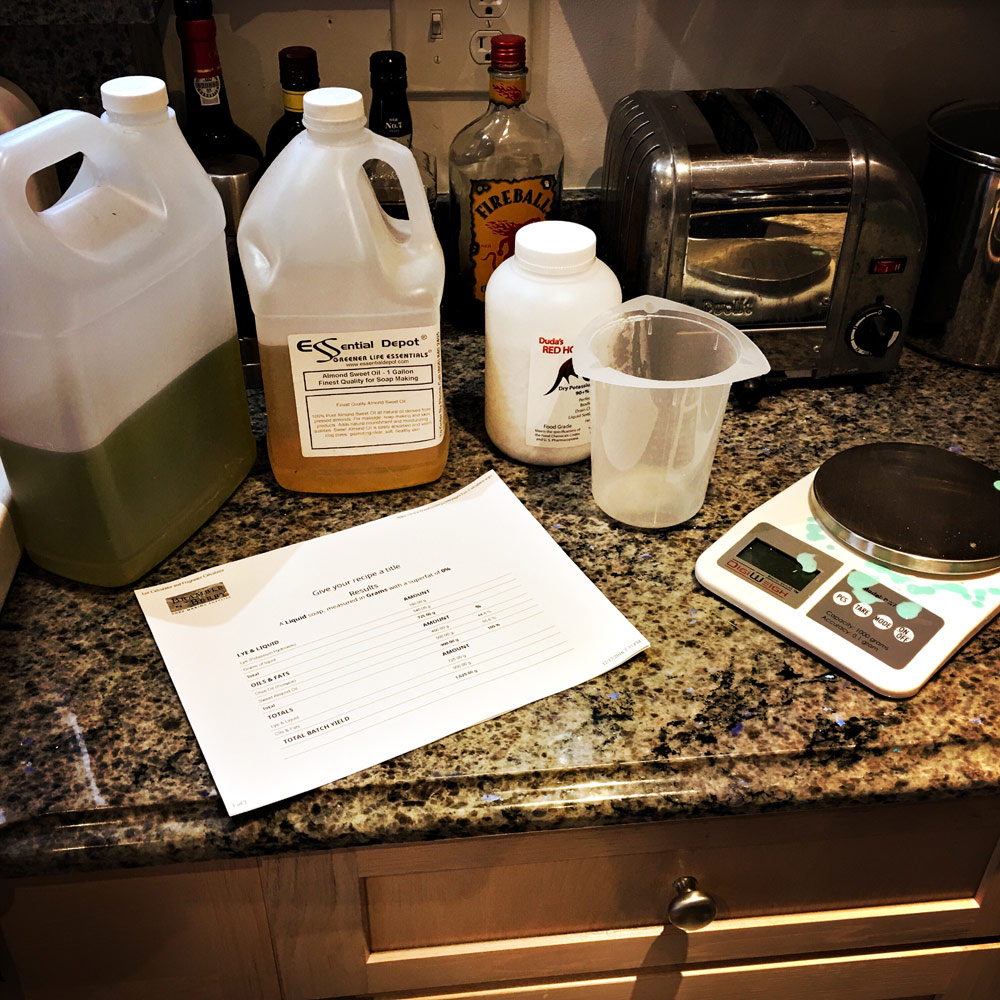
All the stuff!
For some reason the LED lights in my kitchen make my hemp oil look very green!! (I actually pictured different oils here than I have in the recipe. That’s because someone forgot to take a picture of the right oils)

Step 1: Measure the oils. Set the scale for grams and pour 500g of almond oil, then hit “Tare” on the scale and add 200g of castor oil.
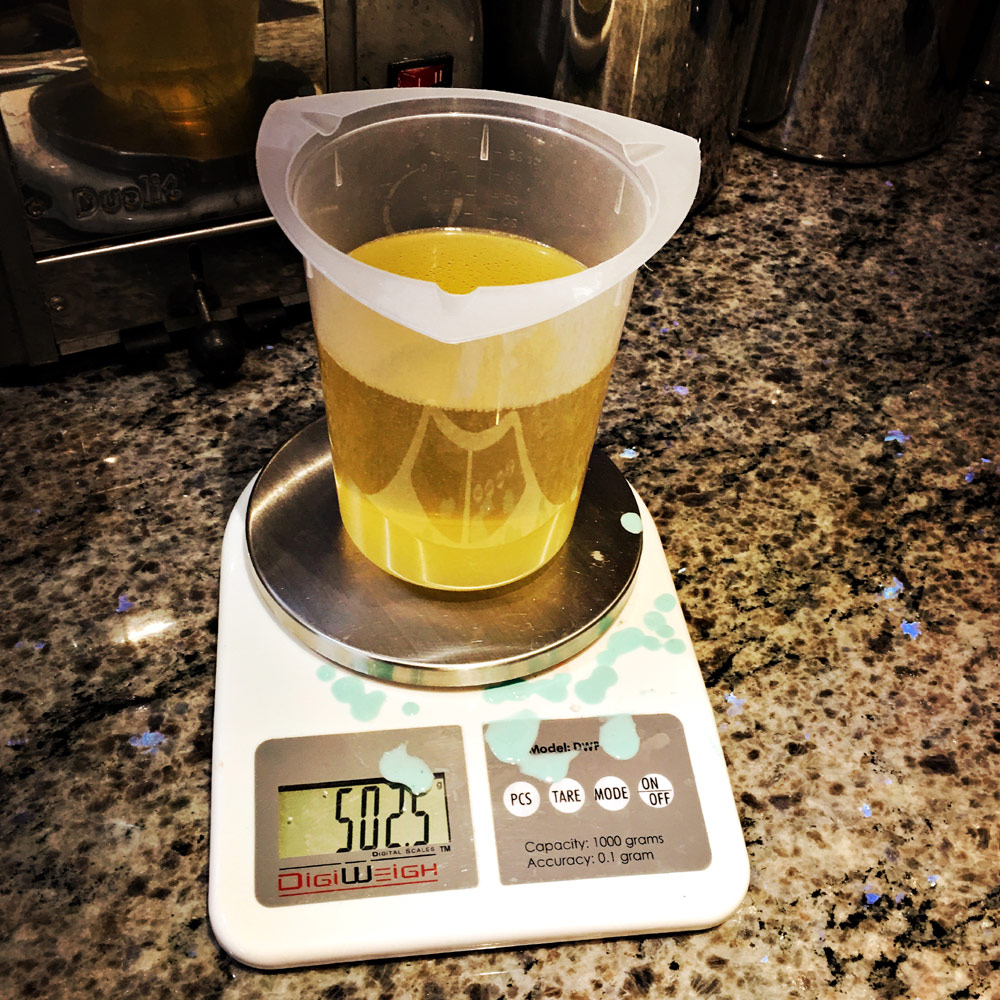
Don’t worry if you go a bit over; it just means that there’s a slight chance all the oils won’t saponify, but it also means you’re less likely to have the soap come out more caustic. In soap-maker-ese this is referred to as “superfatting” – putting more oil in than you need. Some soap-makers go as much as 5% superfat. I just pour sloppily.

The “range:…” shows there’s a lot of latitude in the water. A good rule of thumb is: at least 267 grams of water and nevermind if you’re a bit over.
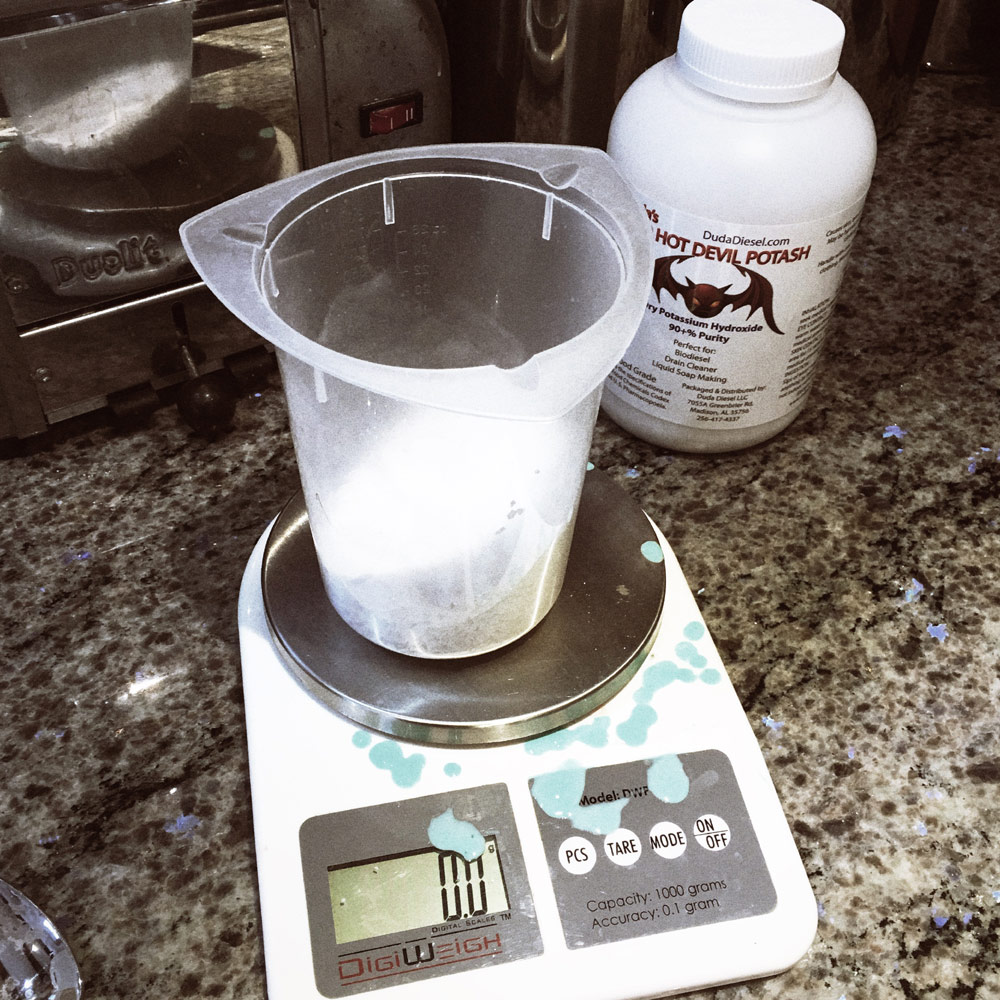
measure out 133 grams of potash, then hit “Tare” and add (slowly, not splashing!) 267 grams of water to it. Stir with a stainless steel something or a spoon. The potash/lye will get hot as it dissolves in water. Set it aside and stir it until it’s clear.
You may see some vapor coming out of the potash/water mix. Resist the urge to sniff it. If your kitchen is remotely well-ventilated it won’t cause you any problem, but if you snort a good breath of that, it’ll make your nose hairs curl.

You’re going to need a biggish thing to simmer the soap down in. I used to use a crock pot but they boil over and it’s safer to use a big pot like this. Keep the lid ajar as shown so water doesn’t steam out, but heat can escape and it won’t boil over.
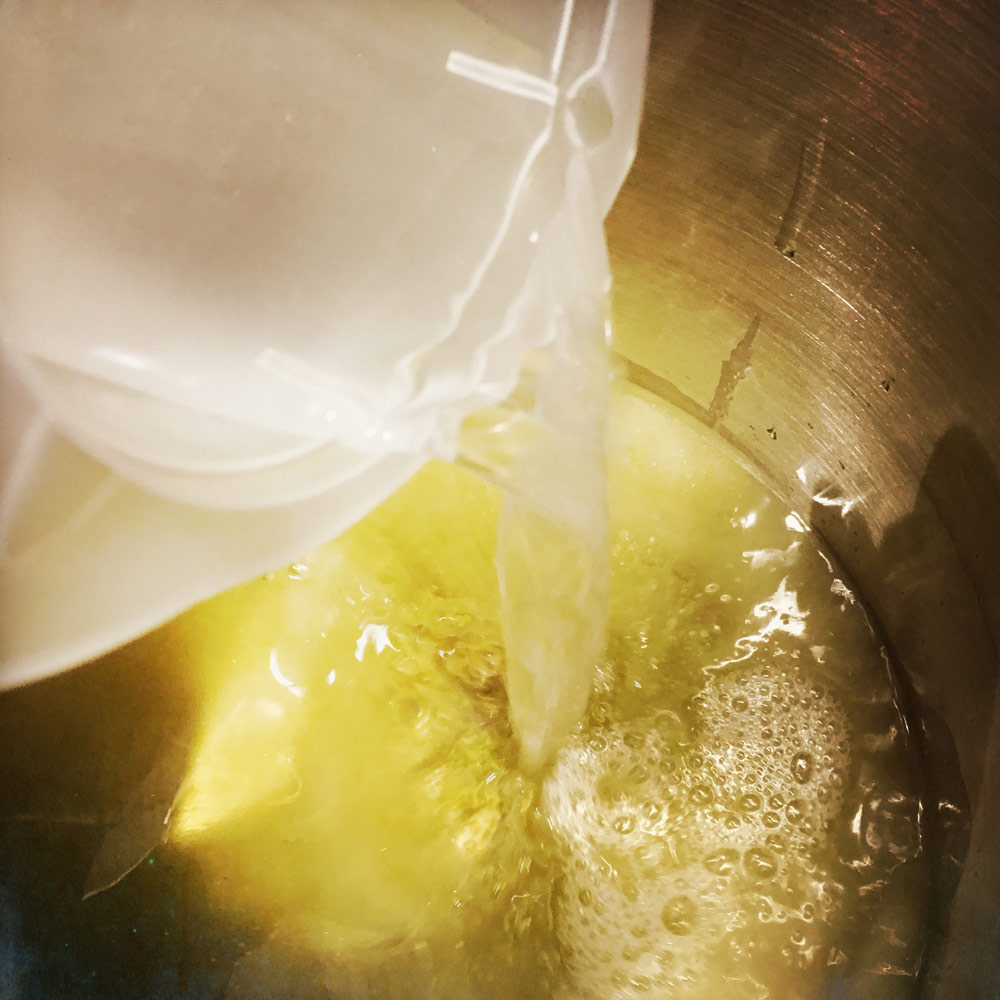
Now you pour the oils into a big pot, and add the potash/water mix. It’s hard to do all that and use an iphone camera so the picture’s not very good. But you’ll see it immediately begin to turn pale where the oils are saponifying.
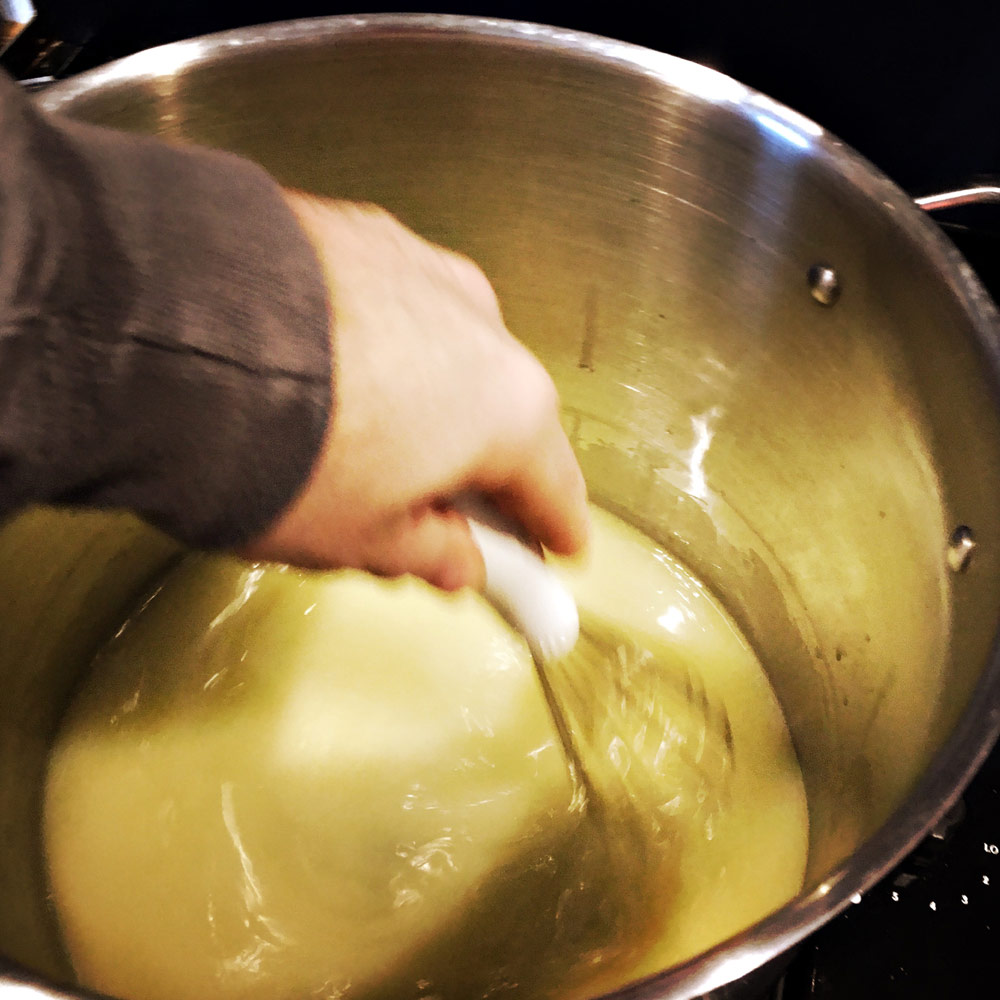
As you stir it up, it starts to get funny – it thickens a bit, heats up some, starts to smell a bit, and gets to be about like honey. That’s called “trace” and is the point where it’s starting to gel. Don’t worry, it won’t gel up – yet.
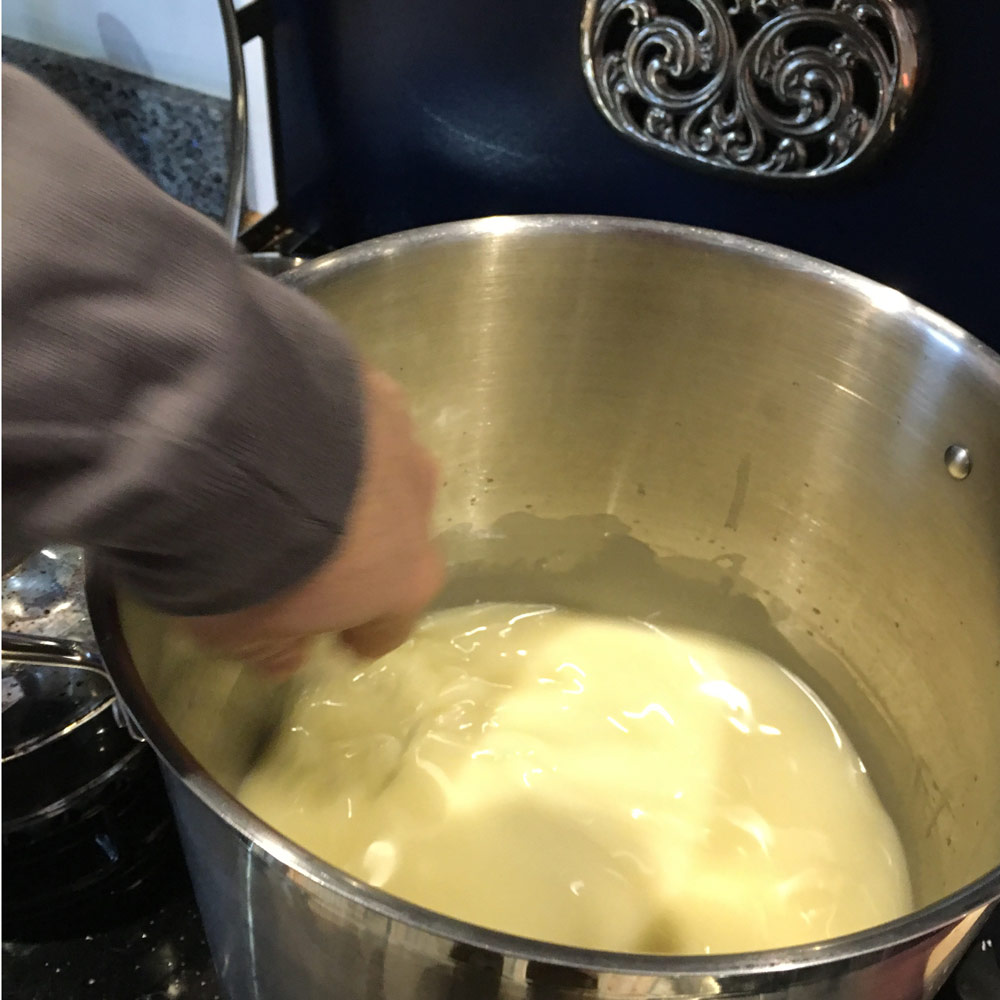
Full trace!
Now, put it on the stove, low setting. Let it sit a while and check on it periodically. It ought to start to bubble eventually. That’s a good sign. You want to stir it every 15-20 minutes and it’s going to undergo some remarkable state changes.

Just started simmering. A few bubbles here and there. You do not want it to boil hard; just simmer like this. In about an hour it’ll change.
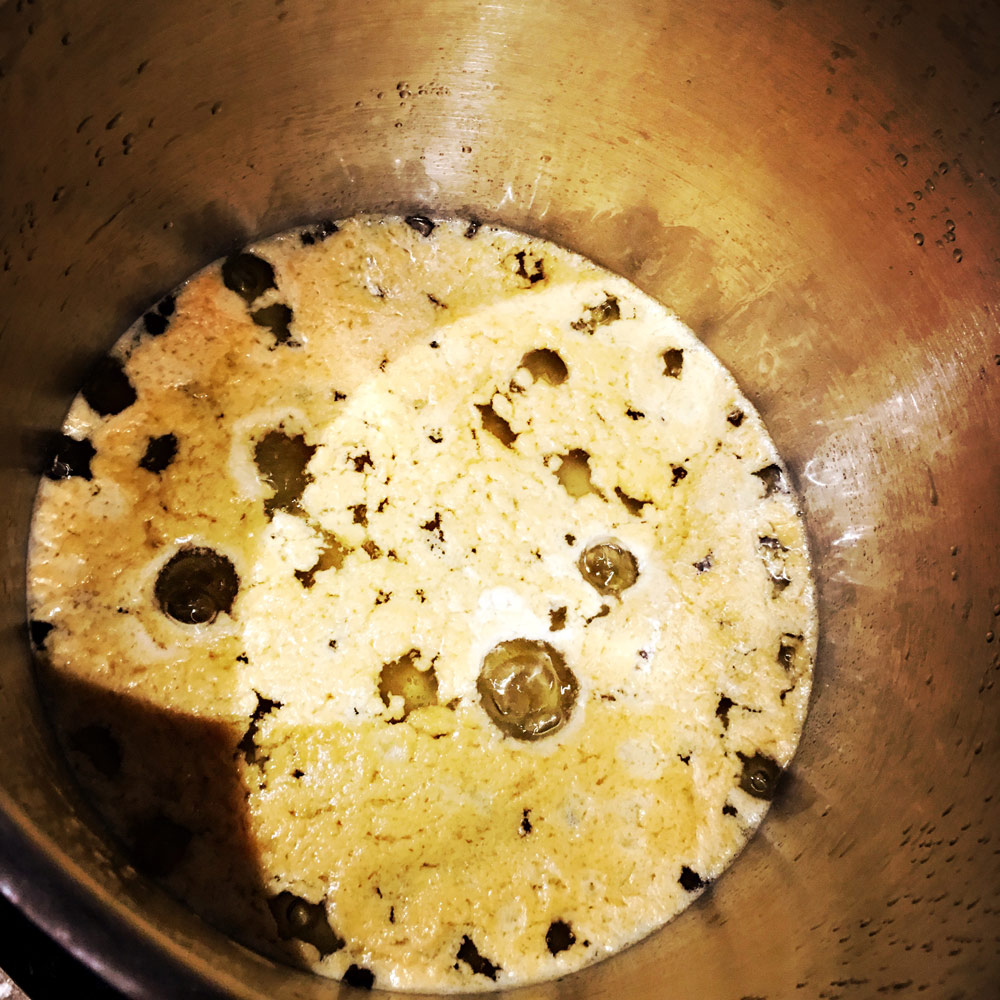
“Scum stage” Here what you see is the stuff that has fully saponified is the clear yellowish liquid, and the remaining solids are fats that haven’t saponified and have curdled. That’s OK – just let the whole thing keep simmering, and keep stirring it periodically until it’s all saponified all the way through. That’s the next stage!

This is the “cottage cheese” stage. It’s basically done about now. But keep the stuff on the stove and keep it warm.
Now, you want to take another pot and put about 1gal of water in it and start bringing it up to a boil or near boil.
If you were to turn it off at this stage a rather horrible thing would happen: it would collapse down into a solid mass that’s strangely impermeable to water. And you’d have one hell of a time getting it out of your pot. Keep stirring periodically while that water’s heating.
Add two tablespoons of borax to the hot water and stir till it dissolves.
Then slowly pour that into the big pot of soap, keeping the heat still going under it. It’s going to congeal into a lumpy goo no matter what you do at this point, but if you put cold water and borax in the pot you’re going to have a lump of gel soap, not a liquid soap.
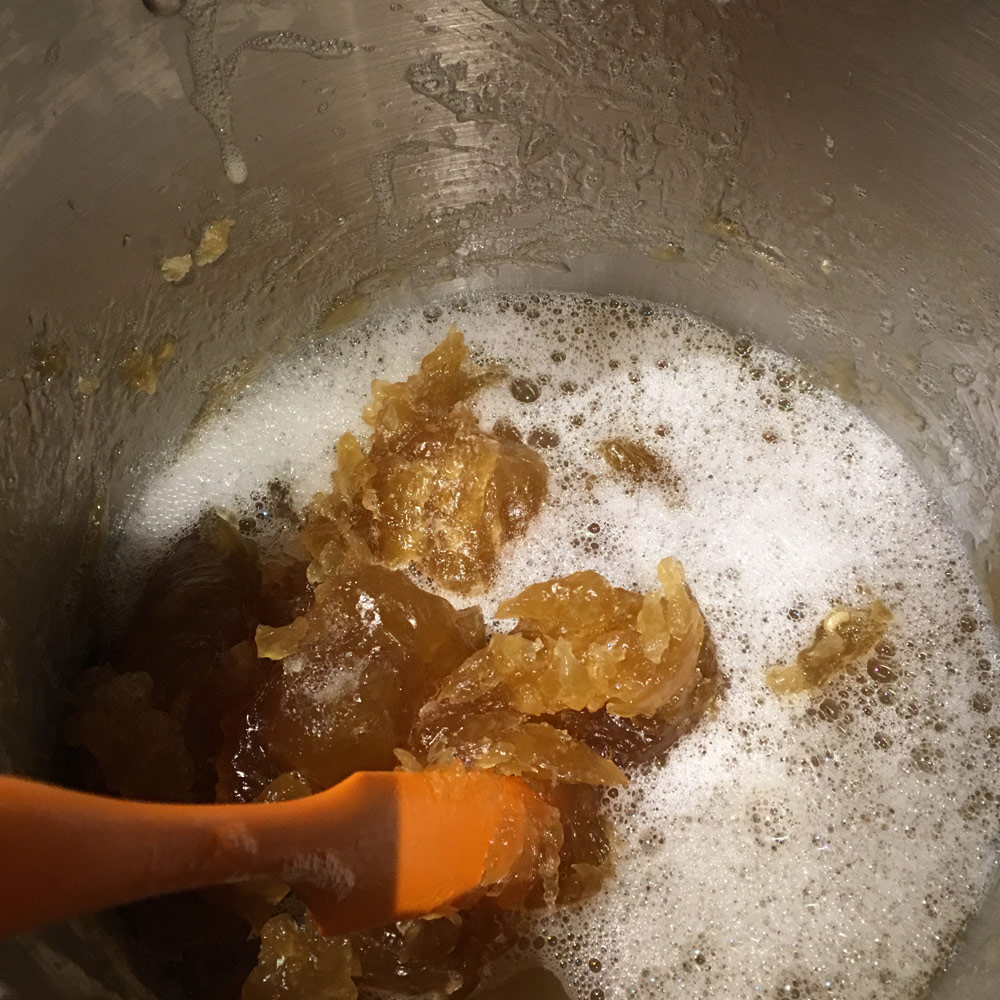
Now you have a gelatinous mass! You need to stir and stir and stir and let it sit and stir a bit more until the whole mass dissolves into the water and: liquid soap!!! You’re done.
Once it’s dissolved let it cool until it’s hot but safe to handle.
A couple optional steps you can make here – If you measured correctly you can ignore this part:
- Take a small amount of the liquid soap and put it in a shot glass or whatever and put it in your fridge to cool. If it solidifies, add more water to the soap, unless you want to store it in gooey gel form. I find it’s best if you can actually pour it when it’s cooled, though I’ve had batches go solid on me. When that happens you just dump them in hot water and re-dissolve them again.
- Take a small amount of the liquid soap and put it in your mouth. Then spit it out. If it burns a lot, your soap is probably too caustic. What do you do, then? I haven’t actually had this happen, ever, but I guess I’d add 1/2 cup of vinegar to the pot, stir it in well, and try again until it doesn’t burn. Another alternative would be to just add a bit more castor oil to react up the potash, then stir it in and let it sit.
- If you want to get serious about your acid/base balance (as long as you didn’t completely mis-measure your potash, you will not have problems!) you can buy a PH meter on amazon and neutralize the soap with acetic acid (vinegar) until it’s just slightly basic. I wouldn’t worry about it. I just put a spoonful in my mouth.
To finish off, what I usually do next is take a couple bottles and swish a bit of rubbing alcohol and water through them (in case there are any fungi or bacteria in the bottles) then dump and shake them, put a funnel in and fill them with the warmish liquid soap, cap them off, and let them sit on a shelf in a dark place for a couple weeks. If the soap throws a sort of creamy “head” on top (looks like a pint of Guiness’) that’s unsaponified oils; pour the soap gently into a pot, use a spoon to skim the “head” off and throw that away, then re-bottle the clear yellowish liquid.

I do not add scent or anything like that to the soap on the shelf. When I’m ready to use it, I usually take a 2 liter bottle, put the soap in it, add scent and whatnot, then dilute it further, and use it!
You wind up with about 1 and 1/2 gallon of ultra concentrated soap. And I mean ultra concentrated. I use about a thimble-full for a load of laundry. When I use it as shampoo, I use a lab dispenser bottle to squirt about a teaspoon worth on my hair and it’s enough for my whole body. So, each of those bottles, which is about a liter, can easily be expanded to a whole gallon of liquid by just adding water. In other words, depending on how you dilute it, that 700 grams of oil makes you about 4 or 5 gallons of liquid soap. I used to feel bad when it was present-time for friends and I’d take a liter of concentrate, cut it into 2 gallons of water, re-bottle it, add scents, and give it out. And the recipients would go “wow that stuff is so concentrated!” Muahaahaa you know nothing!
Favorite additives:
- frankincense, benzoin essential oil, and bay rum (I like having the alcohol in there as a preservative)
- labdanum, ylang-ylang
- sandalwood oil, vanilla
- Murphy’s Oil Soap is: olive oil base, with peppermint essential oil

Soap Guild lye calculator (includes potash calculations for liquid soaps)
I buy my bottles here. If you like containers, Freund is gonna blow your screw-top off. Great service and they have pretty much any container you could ever want. They also have foamer pumps. I like to use industrial strength nalgene LDPE bottles because I ship them around and the postal service might think I am a terrorist if I ship packages that start leaking a clear soapy liquid. (Actually, the postmistress washes her hair with my shampoo, so … if anything did start leaking, I’d probably get a call, not a visit from armed men in black suburbans. Clever, huh?)
Soap should not go bad. The more concentrated it is, the less likely anything will come along that can live in it, but soaps that are heavily super-fatted have oil and water, and bacteria can live just fine on oil and water. A fully saponified soap won’t have any edible oil left in it. But if it smells funky, get rid of it, do not pour it out and reuse the bottles.
Once you do this, you’ll realize what an incredible ripoff laundry detergents are. If you use woolite, at $7 a bottle, you’re paying for about a capful of concentrated soap in a bottle of water. I use the ultra-concentrated stuff, straight, without scent, and a liter lasts me almost 6 months (and I’m heavy-handed with my soap because I just make more) This stuff is super gentle on your clothes and you can smell like frankincense and ginger, or whatever you like!
By the way, another incredible ripoff is commercial shampoo. It’s almost always detergent and the main thing that gives your hair bounce and shine is liquid siloxane. I.e.: silicone. There’s nothing wrong with that, except it kills fish and stuff, but it’s basically adding sticky polymers to your hair. It’s going to help repel moisture, I suppose. Realizing that I probably sound like a soap-kook, I use the same liquid soap base for laundry, shampoo, body wash, and hand wash: the only difference is the scents and concentration I use.
I have a batch (see above) sitting on the shelf! I suppose if any of you would like to try some of my soap, I can send you a sample bottle. You know how to reach me.

Oh, awesome post! Very very interesting. Thank you!
And alas, you have just put a nickel in me… On shampoo: one of the thing you find in shampoo is sulfates. These are detergents and you also find them in dish soap etc. because they are really good at stripping out oils and so on. Is that good for your hair? Well, it depends on a person’s hair type, and what sort of conditioner they are using. If they are using a conditioner with “cones” (basically, silicones, such as dimethicone) these are meant to coat the hair and smooth down the cuticle. This tends to make the hair less prone to snagging on itself and thus it does not tangle as much, looks shinier etc. But on the other hand it is coating the hair and can build up… Sulfates will take it off the hair, and can prevent a build-up. Allthough some argue that sulfates and cones are not good for your hair, it just depends. Not everyone has the same type of hair. For some it is better for their hair to use sulfate- and cone-free products, for other people, their hair positively thrives on these things. That coating of silicone can actually help to strengthen the hair shaft and help prevent breakage.
Sorry about that… really in to hair… :-)
Well, Canadian Intelligence thinks you’re a terrorist anyways. :P
I’m curious about your liquid soap but don’t send it. I got an eviction notice so I’ll be moving in a week or two.
Saponification!!!
kestrel@#1:
I can send you some unscented concentrate soap, if you want. It’s useful for lots of stuff.
Where do you get your hemp oil from?
Essential Depot does not seem to carry it.
The Dr Adorable brand I found on Amazon seems to use the same bottle that’s in your picture…
Patrick Slattery@#5:
I get oils on ebay when I’m being lazy. Right now 32oz is about $12.
I found unrefined hemp oil at newdirectionsaromatics.com for $37 a gallon.
Their oil prices are considerably less than essential depot, particularly so if you buy at least $100 worth.
I have no idea what their service is like though.
Patrick Slattery@#7:
Good to know!!!
Essential depot would occasionally have sales on the big 5gal tubs of oils. That’s how I was getting my coconut oil. I’ll check newdirections out!
So I made two batches with a 20% Castor oil (Bubbly!!), 40% coconut oil and 40% pomace olive oil base.
The first batch I made with just 700g of oils and it came out well but I added a bit too much (12g) peppermint oil (necessary for smell checking if the kids have actually washed their hands or not) so I made a second batch today with 2100g of oils and will use that to dilute down the knock you down whiff of peppermint from the first batch. Just waiting for that batch to cool now…
I did both with the hot process (Basically just turn up the heat a bit and keep a careful watch out for soap volcanos) and they were fully saponified within about 2 hours of adding the KOH to the oil. I checked the PH with some universal indicator strips and I added a little citric acid (~5g per 700g oil) to the finished soap until it stopped reacting and I got a PH of about 8 or 9 which is good apparently. I added a little salt (10g per 700g oil) and rosemary oil (2g per 700g oil) with the peppermint, apparently rosemary oil is a very effective antimicrobial and antifungal agent for soap (Dr Wood’s soaps list it in their ingredients). Hopefully that will inhibit anything from growing in it :-)
The soap is not quite as thick as Dr. Wood’s soaps but nowhere near as thin as Dr. Bronner’s soaps. It’s _very_ bubbly and creamy. I was suitably impressed :-)
Patrick Slattery@#9:
That is So AWESOME!!
Now, be prepared to be the amazement of all your friends and all your wife’s friends (modulo shared sets) and your kids’ friends (who will not care) As far as I can tell the only way to make soap that is insanely sudsy is to add industrial surfactants like Lauryl Sulfate. You can get it on Ebay and I do NOT recommend adding tiny amounts to water and giving it to your kids to dump in community fountains, because the entire fountain will dump out in the form of bubbles… uh… hypothetically.
Well, it’s a great fire extinguisher.
If you want to email me pictures or commentary I’ll be cheerful to post these as “IT CAN BE DONE” proof that I am a satanic saponifier (although “the satanic saponifiers” may be taken as a band name)
Marcus @ #10:
Hi, I didn’t see this comment until now, unfortunately I didn’t take any pictures of the previous batches of liquid soap that I made but I do plan on making some more within the next few weeks so I’ll take pics then.
I’m also going to make some solid castile base soap, I should have the ingredients by the weekend. I’ll take pictures of that too.